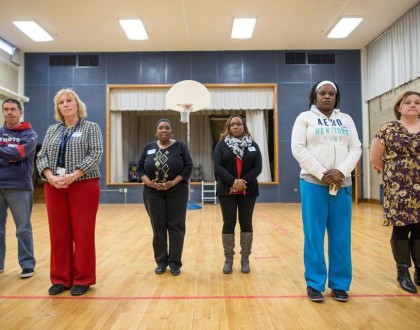Boston Public School Creates Racial Ripple Effect

Good morning. I was invited here today to speak on behalf of 25 parents, teachers and administrators from the Roosevelt K8 School who—thanks to YWCA Boston—shared a powerful experience together last spring—an experience that, to use one parent’s words—is still sending “ripples” through our school community and school district.
I want to start by recreating for you a moment from the Roosevelt School’s race dialogue last April. During the 2nd of our five sessions, our facilitators, Becky and Rosa, led us to the school gym. After lining us all up on the half-court line, Becky and Rosa began to read instructions to the group: “Step forward if both of your parents graduated from college.” “Step back if your parents were not born in the United States.” “Step forward if you regularly see people who look like you on TV.” “Step back if any member of your family has ever been incarcerated.” By the end of the activity, we were spread all across the gym. Generally speaking, people of color stood toward the back of the room and white participants…myself included…had moved toward the front. There was a palpable tension in the air.
We were all members of one school community…all deeply committed to one common cause …suddenly turned inside out. While we’d begun the evening in a tight circle—unified by our experience at the Roosevelt School, comfortable with our friendly morning hellos on the playground, we now stood apart from one another…acutely aware of the beneath-the-surface experiences and stories that differentiate us. Our facilitators, trained to make meaning out of just such moments, held our tension lightly and guided us into a heartfelt discussion. “What do you notice when you look around the room?” “Tell us what it feels like to stand there.”
From our different positions in the room, we began to share our feelings. People voiced guilt, pride, anger, resignation, and compassion. There was no room for passive participation. The visual map of our bodies made undeniable the reality that race matters…that we live in a world in which people’s experiences and opportunities are shaped by the color of their skin…and that there is such a thing as white privilege. As parents and educators, we confronted these truths not just on our own behalf but on behalf of the children we raise and teach…the children whose outcomes we strive to unify even though we know their experiences differ.
Now, didn’t we know these truths before we entered the gym that night? Of course we did—or, at least, on some level we did. The power of this activity was not learning that racism exists. Rather, it surfaced the fundamental stories that people who live and work together every day too often fail to share. This activity—just one moment in the dialogue series—put race on the table in a safe but meaningful way and gave us an entry point into an essential conversation. One participating parent described it as “very much the real thing.”
But the most important question for us today is, of course, “so what?” Beyond providing a thought-provoking experience for 25 adults, what was the point of investing time and money in this experience? What impact does a dialogue like this one really have on a larger community?
That brings me back to the idea of “ripples.”
In a conversation this summer, one of the participating parents described the dialogue as the first stone cast—and spoke to the ripples still emanating from the drop-point.
I think I’ve already spoken to the first level of “ripples”—the individual level. By digging into the difficult subject of race in such a personal way, the 25 of us each walked away with a deeper understanding of our own racial experience and that of our children. Each participant at some point in the series re-evaluated his/her own racial identity. The dialogue was, for me, an unusual opportunity to listen as a parent and not just a principal. At the end of the first session, I shared with the group how much I—the mother of two young children—valued the opportunity to hear how other parents talk to their children about race…to process aloud the challenges inherent in raising children to celebrate and thrive in a diverse community.
The next level of “ripples” is that of the school at large. One of the key components of the YWCA dialogue model is that the last sessions focus explicitly on how participants can share their learning with their community. I was, quite frankly, stunned by the level of energy these final conversations generated within our group of 25—by our group’s commitment to ongoing dialogue and community outreach. Our group agreed to continue meeting as a cohort and to organize more dialogues at the Roosevelt in the coming year. Committed to maintaining the diversity that is a hallmark of the Roosevelt student body, the group also developed a plan for recruiting families of color, retaining white families, and welcoming new families.
And, eager to spread the success beyond our own school community, the group agreed to speak at the 2010 Boston Public Schools Principals’ Institute…which brings me to the final level of “ripples”—that of the school district. In July, participants from the Roosevelt’s dialogue series partnered with representatives from YWCA Boston to present the dialogue model to other Boston principals. The response to the presentation was overwhelmingly positive—so positive that the Director of the Boston Public Schools Achievement Gap Office agreed to fund at least six more schools to participate in YWCA race dialogues this school year.
We, at the Roosevelt, will continue the work we started with YWCA Boston and are thrilled that other school communities will now have the opportunity to cast their stones and create ripples of their own. On behalf of the Roosevelt School, I’d like to thank you for your ongoing support of YWCA Boston—the work done by this organization is truly invaluable.
